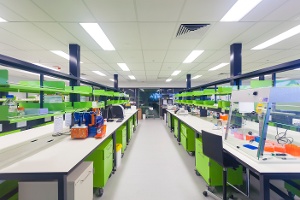Choosing a lab bench work surface is no easy task. You need a lab bench surface to last to get your money's worth, and you don't want to have to replace that surface too soon, especially if you have multiple workstations.
That surface should support you in complying with any regulations or specific industry needs over time as well.
You have a lot to consider. But choosing the right lab bench work surface can be done in four steps:
- Evaluate Your Work Environment
- Examine Whether You Have ESD Concerns
- Determine Your Budget
- Weigh Other Factors
STEP 1: Evaluate Your Work Environment
It's crucial to consider the environment in which your lab bench work surface will be used. Will employees or students use corrosive chemicals, abrasive substances, high heat or cutting tools?
students use corrosive chemicals, abrasive substances, high heat or cutting tools?
While every surface has its pros and cons, some surfaces are more conducive to a particular use. They either resist damage from what your team will throw at them, or the surface is easily, affordably repaired or replaced after extensive use.
Here are a few examples of laboratory work surfaces and the conditions they hold up and don’t hold up well against:
- Phenolic resin countertops have moderate to high corrosive, fungal, moisture, scratch, impact and stress resistance. This material also offers heat resistance up to a continuous 350 °F.
- Epoxy resin countertops are heavy-duty with most of the same resistances listed for phenolic resin. Epoxy resin is also water-resistant and flame retardant. However, a downside is the price, since epoxy resin is one of the most expensive materials you’ll consider.
- Steel is popular because it can stand up to high heat, doesn't promote microbial growth, and can deal with some but not all harsh chemicals. However, this material can scratch and dent more easily, so it may not retain its pristine appearance under regular use.
- Solid surface countertops are easy to repair, but heat and tools can damage this material easily. If aesthetics matter, repairs could become a part of regular maintenance.
STEP 2: Examine Whether You Have ESD Concerns
If your technicians work on electronics, ESD is a major factor. Electro-static discharge can destroy sensitive components and disrupt testing, causing major headaches in the lab. ESD can even be dangerous because in the right circumstances, static can ignite gases such as hydrogen and oxygen, leading to fire or explosion.
ESD laminate countertops are a smart choice for testing or research facilities that have ESD concerns. These lab bench work surfaces have a carbon layer that dissipates static. They're also resistant to staining and certain chemicals (e.g., acetone, gasoline, 10% ammonium). However, they can scratch, so you should take care when cleaning or moving heavy products and devices across the surface.
It's important to note that ESD laminate is not the same as a basic laminate countertop, and does cost around 15% to 30% more than the type of laminate in a homeowner's kitchen, which leads us to the next factor to consider.
STEP 3: Determine Your Budget
Some countertops are more expensive than others, and you clearly have trade-offs. Paying more will typically give you a surface that looks nice and stays functional longer.
give you a surface that looks nice and stays functional longer.
You can get a lot of durability for the price, but even the most expensive lab bench work surfaces have at least one vulnerability, so you need to weigh that against how employees will use the surface. Let's look at some of the prices:
Solid surface countertops are highly customizable with seamless, non-porous surfaces, and that comes with a price. Solid surface countertops cost anywhere between $50 and $200 per square foot.
Phenolic resin averages $15 and $18 per square foot. Chemical laminate (melamine resin) is more decorative on top of functionality and can run $20 to $80 per square foot. Epoxy resin countertops can cost anywhere between $100 and $200 per square foot, but are one of the most resistant materials to harsh conditions found in a lab.
It's vital to look at the whole cost of ownership rather than focusing solely on upfront costs, however. Other costs to budget for include:
- Lead time: How long you have to wait for the initial product, a repair/replacement, parts, etc. This could lead to downtime or project delays, which certainly impact cost and productivity.
- International shipping: Let's face it, we may often purchase things from overseas and they're cheaper, but when you factor in international shipping, inability to return something or get replacement parts, customs delays and timezone issues, it often ends up costing more.
- Customization: The more customization you need, the more you'll generally pay for a given lab bench surface.
- Adaptability: You don't want to spend a lot on a surface only to find it doesn't meet your needs five years out. Some ability to adapt and customize as needs change is critical to keeping costs lower vs. having to buy something completely new.
- Repairs and maintenance: Can you perform repairs in-house or do you have to hire a professional? Sometimes lower-priced surfaces mean you have to repair or replace more often, and other times the added maintenance is worth it for the benefits of that surface in your specific lab environment.
STEP 4: Weigh Other Factors
Long lead times can impact productivity as mentioned above, so find out what to expect from your manufacturer by talking with them, checking out testimonials and looking for online reviews. Other factors to consider include:
- Aesthetics aren't only something pretty to look at. They can set the stage for more engaged, productive and mindful work. In line with the Broken Window Theory (Wilson & Keller), which has a lot of real-world applications, when employees and students work in a place where surroundings look nice, well-cared for and clean, they tend to take better care of the equipment and do better work.
- Colors and patterns can make a space “feel” a certain way. They can align with your brand and promote unity among lab scientists and technicians. They can energize a space and promote creativity, so yes, customizations like these matter.
- Some edges hold up better in certain environments, while others may be easy to chip, catch or scratch, but this is highly subjective, depending on how people use the lab space, so you'll certainly want to consider it.
Choosing Lab Bench Work Surface Materials
You have a lot to consider to ensure you buy work surfaces that last you a long time and cost you the least for the most benefits. Work with a quality manufacturer/partner who takes time to listen and understand how you'll use the surface and help you make a choice you and your boss will be very pleased with in the end.
Lead time matters, and, of course, communication is key. Work with someone who can customize your workbenches to meet regulatory, ergonomic and industry standards, all while promoting function, safety and productivity you need in a modern laboratory environment. An experienced manufacturer makes sure you get this important decision right.


